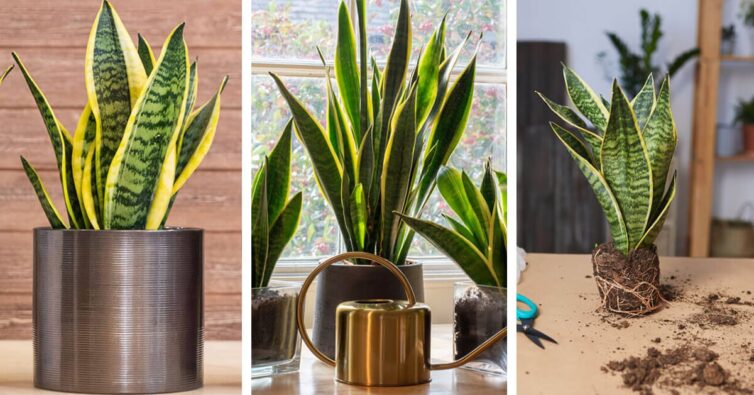Snake plant is one that you’ll see commonly in many gardens. One of the main reasons for its popularity is that it’s incredibly easy to grow and care for. You can find decorative indoor snake plants on all continents, where they receive a warm welcome.
Key Takeaways
- Snake plants are popular indoor plants due to their low maintenance and adaptability.
- They tolerate a variety of conditions, including direct sunlight, shade, and occasional underwatering.
- While relatively pest-free, they can attract certain insects such as aphids, mealybugs, thrips, and gnats.
- There are around 70 species, with some popular ones being Bird’s Nest, Cylinder, Rhino Grass, Starfish, and Whale Fin.
- They prefer wide, shallow pots and can grow rapidly, needing division and repotting.
What is Snake Plant?
This particular indoor plant tolerates direct sunlight and shade, dry air, drafts, and underwatering (talk about low maintenance!). Snake plants are tough as nails without losing their noble appearance. There are few architectural forms where the snake plant wouldn’t make a great addition.
At first glance, you might think the snake plant has stems. It’s just an illusion. Those are thick, upright leaves, but for certain dwarf varieties bearing rosettes of leaves. Colors among snake plants include green and silver-gray. Some have cream or gold edges, but all have horizontal streaks.
Snake Plant Positivity – Feng Shui: In Feng Shui, the snake plant holds a place of honor thanks to its ability to absorb negativity, especially jealousy and desolation. Additional symbolism includes tenacity, good fortune, and freshness. It’s often a housewarming gift for happiness built on a foundation of mutual effort.
Caring for Snake Plants
A striking appearance isn’t all the snake plant offers. For the most part, you can pot it and walk away. If you miss a watering here or there, things will be fine. There are some ways, however, to improve the health of your snake plant today and in the years to come.
- Dusting: It’s natural for a snake plant’s leaves to collect some amount of dander and dust. Nothing fancy here. Just grab a damp cloth and wipe them down.
- Containers: Your plant needs a wide, shallow pot (terracotta is a great choice). The diameter of the container should be twice the size of the root ball.
- Growth: Snake plants can grow far more quickly than anticipated. If you notice your plant looking like it’s about to burst out of the pot, you can divide it and put both halves into new planters.
- Overwatering: the most consistent problem with snake plants is that people overwater.
- Sunshine: Partial sun is best for snake plants. It will grow in darker areas, but full shade will kill it over time. If your plant’s leaves are sad looking-dull and floppy, give it more light.
Fresh Air Relief: NASA has done several studies on plants to see if they can improve overall air quality. Snake plants (along with other succulents) have the ability to filter indoor air pollutants like benzene, formaldehyde, and xylene. Additionally, snake plants can convert CO2 into oxygen. As a result, some people who suffer from allergies may get a little relief from a snake plant in their home.
Indoor Snake Plant Needs
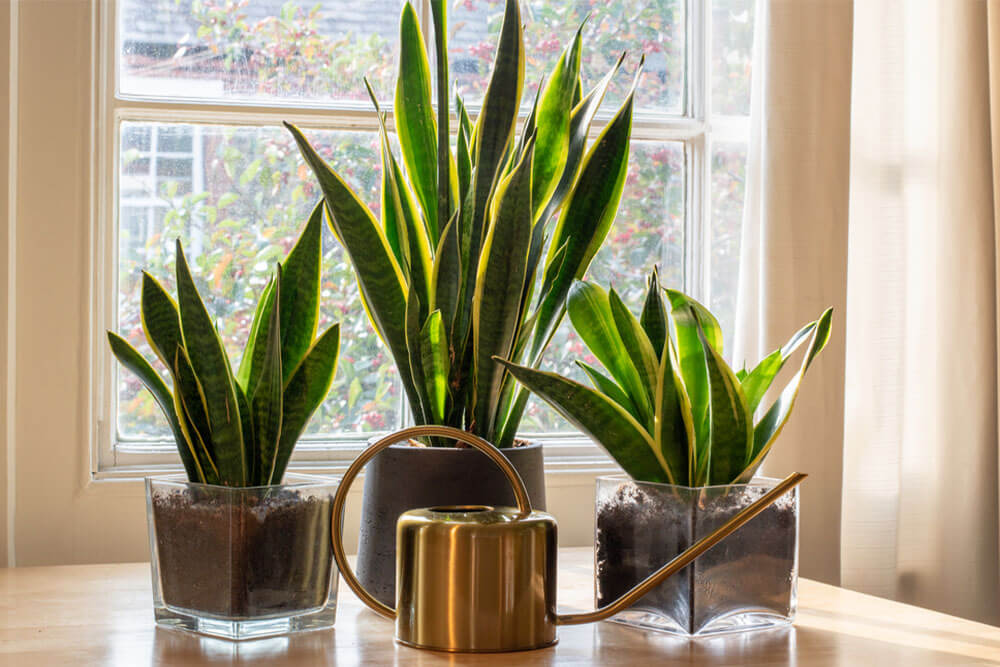
You’ll find the company of snake plants undemanding and cordial. They, like any plant, have a few things that keep them healthy.
Keep your snake plant in bright but indirect light. If your plant isn’t getting enough light, the leaf colors wash out, and they sometimes become wilty. Just change their location.
Soil for snake plants is nearly as uncomplicated, as are they. A 50-50 cactus/succulent mix is ideal. Make sure when you plant, you don’t impact the soil. Keep it airy. Fertilizer is also simple. Give it a dose of normal houseplant food in spring and summer. Add a little compost, and you’ll have a very happy plant.
It’s easy to lose track of your snake plant. It’s just “there.” After a few years, however, you need to provide a little TLC by way of repotting. Being root bound for a short time is ok, but it shouldn’t remain that way. Plants in low light may not need attention for a decade, while those in brighter light often require repotting every 3-5 years.
Propagating snake plants is nearly as simple as growing and caring for them! Using clean scissors, cut a 4-inch section of a leaf. Stick it into a pre-prepared container of potting soil. Moist the little leafling evenly for about 4 weeks. You should notice little babies growing from the cutting’s base. You can grow these together or separate them for more plants.
Which Indoor Snake Plant Should You Buy?
There are about 70 species of snake plants, some of which have more popularity than others. Here are a few for your consideration.
- Birds’s Nest (Hahnii): In a word: adorable! This snake plant won’t grow much more than 6 inches tall, making it a great addition to office spaces. The Golden Hahnii has variegated leaves with a lovely edge of yellow.
- Cylinder: True to its name, the cylinder snake plant has round leaves. The plant grows to several feet in length. The leaves burst out all around this plant, looking like a crown.
- Rhino Grass: If you want an item to give your indoor garden variations in height, try Rhino Grass. It grows in a very tight clump, so it doesn’t take up a lot of space. One version of it, bearing the nickname Elephant’s Toothpick, has leaves that grow into a fan-like shape.
- Starfish: As you’ve probably guessed, this snake plant grows into the rough shape of a starfish. It has thick leaves stripped horizontally.
- Whale Fin’: A unique snake plant that grows into what appears to be a whale fin breaching the soil. It bears huge, paddle-shaped leaves measuring up to 12 inches across. They are mottled, looking like light and dark green zigzags.
Warning: Snake plants are toxic not only to cats and dogs but also to young children. Keep this in mind when considering a safe location in your home.
Watering Techniques for Snake Plants
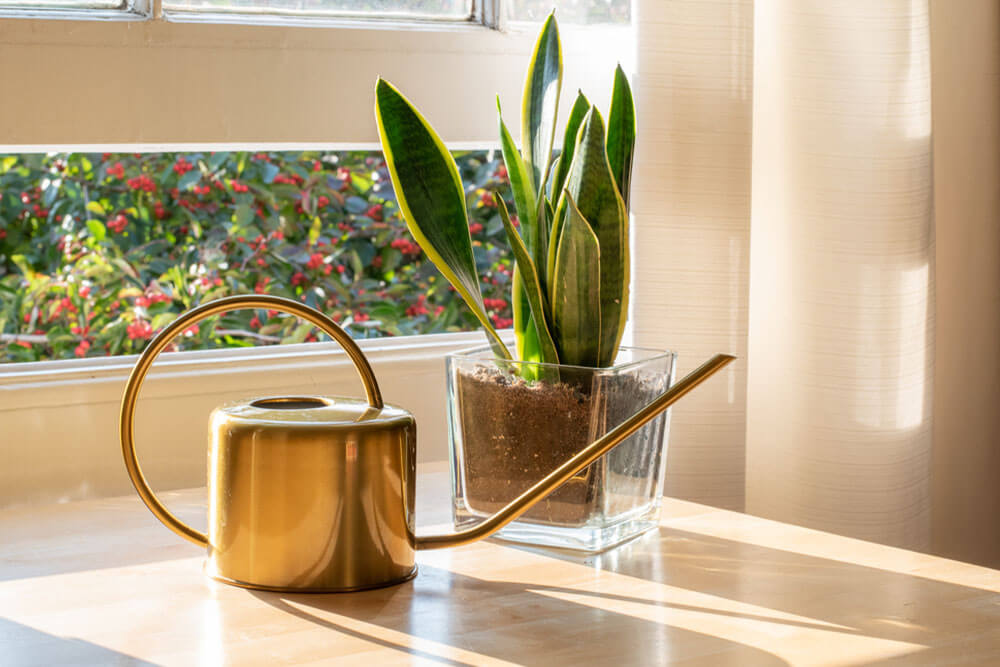
We cannot stress the need for proper watering of snake plants enough. Don’t be shy. Stick your finger into the soil 2” down. Is it damp? Then wait a while. You can also use a tongue depressor, which is an inexpensive tool for showing the water level nicely.
When practicable, water from the bottom of the pot. It’s a simple way to encourage deep-root growth. You need those roots to keep leaves stabilized.
Snake plants have a variety of nicknames. These include mother-in-law’s tongue, viper’s bowstring, devil’s tongue, jinn’s tongue, ribbon plant, snake palm, silver queen, life plant, and friendship tree.
One name from Spain, St. George’s Sword, is particularly telling. The sharp-ended leaves look like a sword worthy of slaying a dragon.
How to Pot and Repot Your Snake Plant
Once you learn about potting, you also know nearly everything you need to repot. Think of it this way. You bring your snake plant home in a greenhouse container. So, effectively, you are “repotting” or “transplanting” it into a new home.
In both potting and repotting, you need a container with excellent drainage holes. Terracotta materials are one choice that helps with water wicking. Use a potting mix designed for succulents and cacti. This soil won’t hold water as easily.
When you remove the plant from the original container, put it into the new pot at the same depth as it was previously. Once you’re done, it’s time to find a perfect location for the addition to your indoor garden. Look for areas with indirect light that are still bright.
If you must use a shady area, make sure to move them into the light regularly. Do so slowly (inches at a time) so the plant can adjust to new light levels. Quick changes lead to plant shock.
Snake Plant Strings: Snake plants are native to Africa in the tropics. One type, Dracaena trifasciata, produces impressively strong plant fiber akin to hemp. As a result, those fibers became bow strings for hunting.
Pruning and Maintenance of Snake Plants
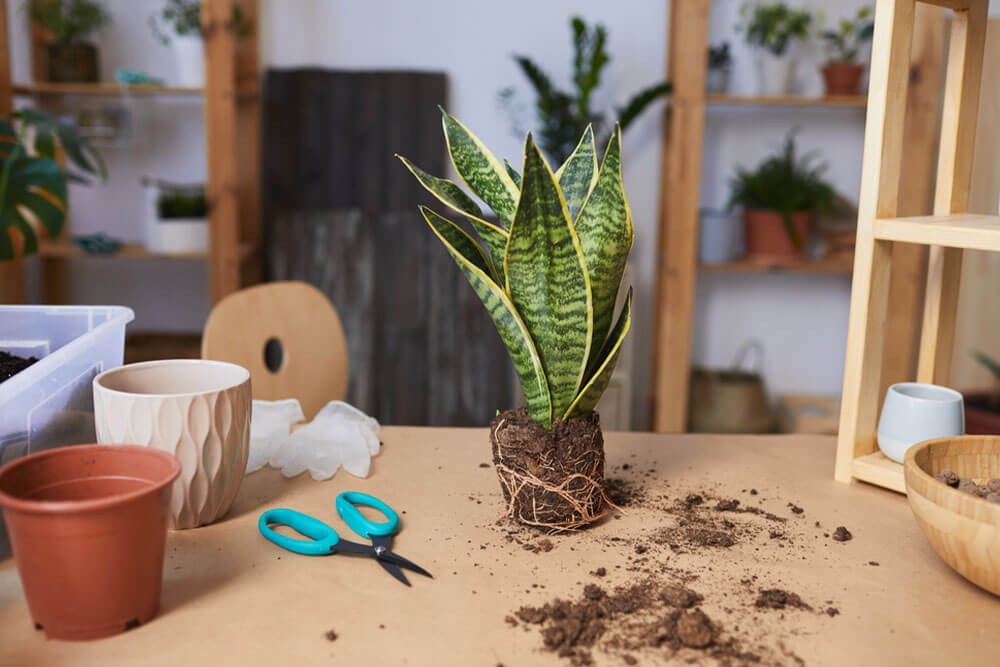
When your snake plant is actively growing, pruning encourages new growth. It also keeps the height of the plant under control by trimming the tallest ones at the soil line. Get rid of damaged leaves. If you see brown tips, it will not hurt the plant if you remove them. Also, if any leaf falls over, it’s just become too top-heavy. Prune those too.
Things are Looking Up: Snake plants rarely bloom indoors. When one does, it’s an omen of prosperity and blessings. Be on the lookout for opportunities coming your way.
Do Indoor Snake Plants Have Blooming and Resting Periods?
The simple answer to this is not really. Since snake plants rarely blossom indoors, there’s no knowing for sure when they might surprise you with creamy white, tubular flowers smelling of lily. If you let your plant be somewhat rootbound and provide a little more sunlight, fertilizer, and water, who knows? They can have a batch of petals once every 2 years if you’re lucky.
The snake plant’s flowers are about 1 inch in diameter. What makes them stand out, literally, are stalks measuring 3 feet tall. These lovely gifts only last a few days, so enjoy them fully.
By the way, snake plant flowers have a built-in clock. It remains closed all day, only opening at night.
If you put a snake plant in your bedroom near your headboard, the resulting energies will disrupt your relationships. The reason may be the poisonous nature of snake plants if you eat the leaf.
On the other hand, in China, shake plants were a treasure in any home. When you have one, Eight Gods bless you with longevity. Beauty, creativity, prosperity, keen-mindedness, health and strength. This association is stronger if you actually cultivate the plants.
Indoor Snake Plant Pests and Problems
Like many other succulents, the snake plant is relatively pest-free. The most common insects that cause trouble are those that target many indoor gardens.
Insects
- Aphids: these creatures come in green, yellow, pink, brown, or black. They’re about ⅛” long. Aphids lose their exoskeletons as they grow, and you may find them on leaves. Signs of aphids include twisting leaves, yellowing foliage, and very slow plant growth.
- Mealybugs: a white waxy veneer on oval bodies. Mealybugs weaken your plant. Signs of an infestation include black sooty mold or cottony egg masses.
- Thrips: a tiny, slender insect. Look for discolored scars on your plant.
- Whiteflies: Tiny flies (1/10”) with white wings. Signs include leaves mottled in yellow and a sticky slime they leave behind.
Nasty Gnats on Snake Plants
One of the more aggravating bugs that love snake plants is gnats. These little black bugs hover around the leaves but prefer the safety of the leaf landing pad. When you disturb them, you suddenly have a cloud of bugs resembling tiny mosquitos. Their larvae (5 mm) live in the soil and look like bleached worms.
Fungus gnats, probably obtained through the greenhouse soil, are a nuisance. They are hitchhikers you probably won’t notice. Once they’re in a snake plant’s container, they’re pretty determined to stay. This is one reason you should always put a purchased plant into fresh soil, discarding the commercial leftovers.
The good news is that gnats won’t kill your plant. In fact, the adults don’t eat the plant. They just use the space for mating and laying eggs. The larvae are likely to eat rotting bits in the soil before moving on to the snake plant’s roots. The flies are the giveaway that more’s happening beneath the soil than you see directly.
Sticky Traps for Gnats: One simple way to decrease the surplus population of gnats is by using sticky traps that go right into the pot. These products have bright colors which attract the gnats. You can make your own by having a bright-colored bit of card stock and covering it with petroleum jelly. Prop it like a little flag in the soil.
An alternative is hydrogen peroxide. Find a 3 percent solution. Mix this in a 1:3 ratio and use it the next time you water.
Diseases
Time and time again, root rot is the cause of sick plants. Over-watering is the culprit and one that’s easily resolved through a proper watering schedule and a pot with excellent drainage. When root rot is present, gently remove the plant from its container. Break away old media, get rid of dead roots and leaves, then repot your plant in new soil.
There’s also powdery mildew. It’s a fungus that covers plants in a powdery coating (hence the name). Move your plant into an area with more light, warmer temperatures, and low humidity.
While Snake plants are succulents, they are not cacti. The confusion comes from the appearance of the plant, namely the thick leaves. Snake plants have structures similar to jade plants, aloe vera, and agave plants.
Troubleshooting Common Snake Plant Problems
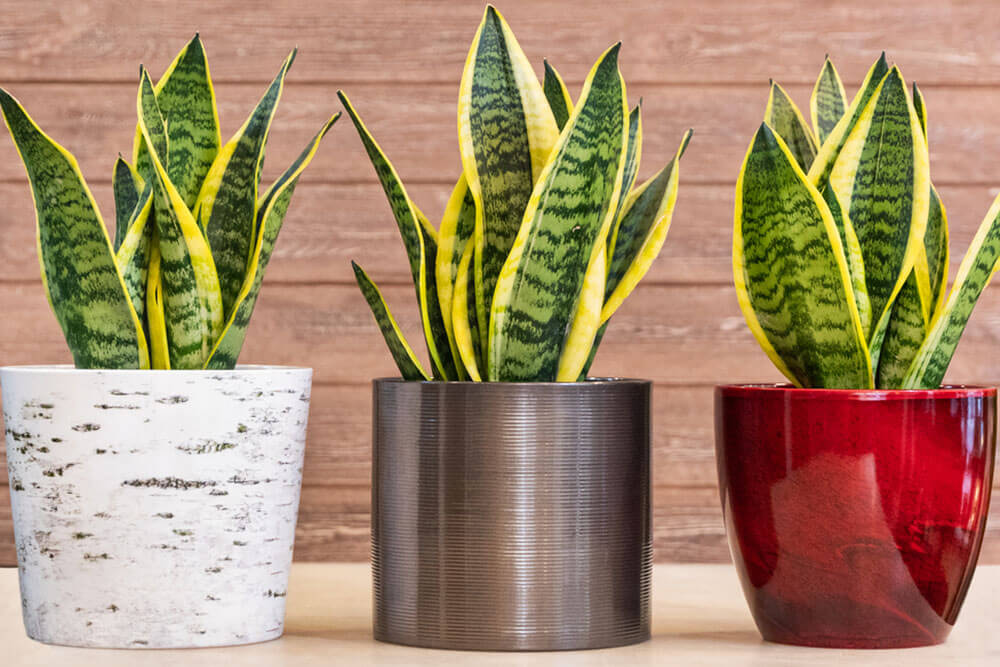
While snake plants are among the easiest to maintain, there are a few things that may pop up, leaving you scratching your head.
- Browning or yellow leaves: There are three potential causes here. The plant may be developing root rot. It could have pests, or you may be over-watering it. Check the roots, review the leaves, and make sure the soil dries out between waterings.
- Curling Leaves: Thrips are the most likely problem. Cut away leaves with severe damage and give the whole plant a good spray with neem oil.
- Droopy Leaves: The plant literally looks sad, like it’s pouting. Your plant might need more light. Also, reduce the watering frequency.
- Fetid Soil: When your plant smells like old gym socks, you probably have root rot. Remove the plant and check the roots. Clean away mushy and dead ones and repot them to get them back to health.
A Living Fence: Should you decide to grow snake plants outdoors, certain varieties grow large. Under the right conditions, they reach 8 feet tall. If you plant them side-by-side, they’ll slowly become a fence-like feature.
Astrological Signs Suited for Growing and Caring for a Snake Plant
In the early stages of developing sciences, astrology was the precursor to astronomy. As time wore on, people categorized nearly everything under the sun as having associations, including the signs of the zodiac. There are three sun signs suited to the snake plant.
Aries
Aries is a Fire Sign ruled by Mars, making it bold and filled with ambition. Because Aries is always on the go, the snake plant is a perfect household partner. It’s nearly impossible to kill. If you get busy and forget to water for a bit, no issue. Bonus: The leaves look like swords, perfect for Aries’ inner warrior.
Capricorn
Just as the snake plant endures, Capricorns rarely give up. They work hard with specific goals in mind. Capricorns have a career path that you cannot shake. Where snake plants can survive drought for a while, Capricorns will sometimes forgo all else (even sleep) to reach the finish line. With this in mind, the snake plant can travel to the office, keeping the air clean along with supporting clarity.
Scorpio
Snake plant has the nickname of Mother-in-Law’s Tongue. If you meet a Scorpio, prepare for a sharp approach to communication. Don’t ask a Scorpio for an opinion they shoot from the hip with no buffers. Snake plant ushers in good luck for people born under this sign.
Summary
It’s nearly impossible to kill a snake plant. In terms of durability, it can endure a missed watering or two and both bright light and low light conditions. While it might be tempting to add this plant as a decorative touch in your bathroom, this isn’t good for the snake plant. Think dry for a delightful mature plant.
[wp-faq-schema title=”Frequently Asked Questions About Snake Plant Care” accordion=1]
